Smart Grid and Renewable Energy
Vol.2 No.4(2011), Article ID:8273,11 pages DOI:10.4236/sgre.2011.24039
A WiMAX-ZigBee Energy Management System for Green Education
![]()
1Department of Electronic Engineering, City University of Hong Kong, Hong Kong, China; 2School of Engineering & Mathematical Science, City University London, London, United Kingdom; 3State Grid Energy Research Institute, Beijing, China.
Email: *ee330015@cityu.edu.hk
Received July 12th, 2011; revised July 23rd, 2011; accepted July 30th, 2011.
Keywords: Energy Management, Minimizing CO2 Generation, WiMAX, ZigBee, Green Education
ABSTRACT
A WiMAX-ZigBee energy management system for green education has been developed. The system helps to resolve the disgusting environmental problems. This paper explores the concept of energy management and introduces an Energy Management System located at campus areas. Analysis shows that 30% energy can be saved from the total energy consumption which translates to a saving of 72 thousand million kWh of energy annually. Such saving reduces 48 million tons of CO2 emission for the environment.
1. Introduction
Recently researchers have been looking for the possibility of energy sources other than coal, oil and natural gases [1] since these natural resources are expected to deplete after decades. The energy crisis will remain unsolved unless an efficient approach has been used. Instead of seeking new energy sources, the current energy consumption has to be well managed in order to alleviate energy problems. Alternative methods generating electricity are proved to be inefficient as the corresponding resources will be depleted. Fundamentally, the principal method is to manage the efficiency of energy usage.
Energy management is originally is an add-on feature of home automation. In [2], Gutzwiller and his colleagues presented the first generation of home area network, Homenet enabled wide range of features such as on-off remote controls, energy management, security, entertainment module coordination, and clock synchronization by using telephone system and PowerLine communication technology. Until 1983, Matty proposed a first energy management system using telephone and PowerLine communication which was originally aimed at providing the timely dynamic pricing information to the end user site in order to achieve the demand side management [3]. To further investigate the complete design of the energy management system for utility load management, Wacks [4] pinpointed the importance of personal computer artificial intelligent software for energy consumption optimization. Since PoweLine communication was involved in most of energy management system proposal, Kelly and his colleagues had conducted performance and reliability experiments in actual residential environments using the CEBus standard [5]. In order to merge the home area network to internet, Inoue and his team members had delivered the design of gateway controller and network architecture of second generation of energy management system which combined the technology of internet and PowerLine communication [6-7]. Apart from PowerLine communication, Lien and his partners put their effort on developing a wireless solution (fusion of GSM and Bluetooth) for third generation energy management system [8]. Unfortunately, the proposed wireless energy management system supported eight appliances only due to the limitation of Bluetooth. The recent technology breakthrough of wireless sensor network has repositioned the development of energy management system. ZigBee is a global protocol standard for short range communication which is developed for home automation, energy management, remote monitoring and building automation. With mesh capability, ZigBee supports up to 65000 nodes in a single network and expands the ability energy management from an apartment to a building or even a campus.
In this investigation, an energy management system based on WiMAX & ZigBee Energy Management WiZEM is proposed for campus with multiple buildings. The system fuses the next generation wireless communication technologies, ZigBee [9] and WiMAX [10,11], to provide campus-wide coverage for energy management system. ZigBee is suitable for short-range transmission within buildings and WiMAX is the best candidate for transmission between buildings. This combination of ZigBee and WiMAX is referred as the WiZEM system. Not only green education is cultivated, students also experience the next generation wireless technologies. The support by fuzzy intelligence also helps monitoring energy consumption. In the mean time, the message of energy management concept is conveyed. Green education is receiving increasingly emphasis in education, and hence the proposed WiZEM system serves to receive the most impact for green campus. This paper is organized as follows: the system design is discussed in Section 2, and the system architecture is discussed in Section 3, the analysis and performance evaluation is performed in Section 4. The conclusion is drawn in Section 5.
2. WiZEM Design Overview
The target users for the proposed energy management system are teaching staffs and students. A series of components are designed for respective users and are listed in Table 1. With the use of ZigBee and WiMAX, the coverage area can be broadened to the whole campus area with a number of buildings. Moreover, the absence of wirings saves much deployment costs. The performance is also enhanced by these wireless technologies through collaboration with different roles in the system. The system design is defined primarily by the wireless technologies used.
2.1. Rationale to Use Wireless Technology
After categorizing the wireless technologies used, the proposed system can be described as a three-tier structure comprising three levels, namely, the ZigBee Device (front end subsystem), the ZigBee room agent and WiMAX-ZigBee Gateway (Communication Infrastructure) as well as the energy management server (Backend system). The conceptual diagram is shown in Figure 1 and the tier structure of system components are shown in Table 2.
2.1.1. Front End Subsystem
The front end subsystem consists of the ZigBee components listed shown in Table 1. These includes sockets, switches and remote controls. The system collects information such as energy consumption, room temperature, humidity etc. for the operation of energy management

Table 1. System components description.
server. Apart from data collection, the front end subsystem executes the control command from users as well as the backend system. The use of ZigBee sockets and light switches further consolidates the energy saving concept by managing the power supply. As the socket and the light switch are specially designed for energy management, key functions including record of energy consumption details and scheduling of supplying period are devised. The system deploys the sockets and the switches throughout the campus instead of using traditional sockets and switches. The consumption details in every socket and switches are available for monitoring.
In addition, the ZigBee sensors are used as a scout to detect environmental conditions. By placing ZigBee sensors (temperature, light intensity and humidity) at appropriate locations, these real-time indoor conditions optimize the use of air-conditioners and lightings. Unnecessary consumption can be avoided after the adjustment by fuzzy intelligence [12] in the control center. The underlying principles to work out the above features are based on the salient properties of ZigBee. Once a request is detected by the switch or the socket, the switch/socket forwards the request as a ZigBee packet to the room agent and relay to the energy management server via a WiMAX-ZigBee gateway for processing. ZigBee is a wireless personal area network WPAN standard of IEEE 802.15.4 [9]. It has some distinctive characteristics of short-range transmission and low data rate. An outstanding feature for energy management is the amazingly low energy consumption with an extended life-span over
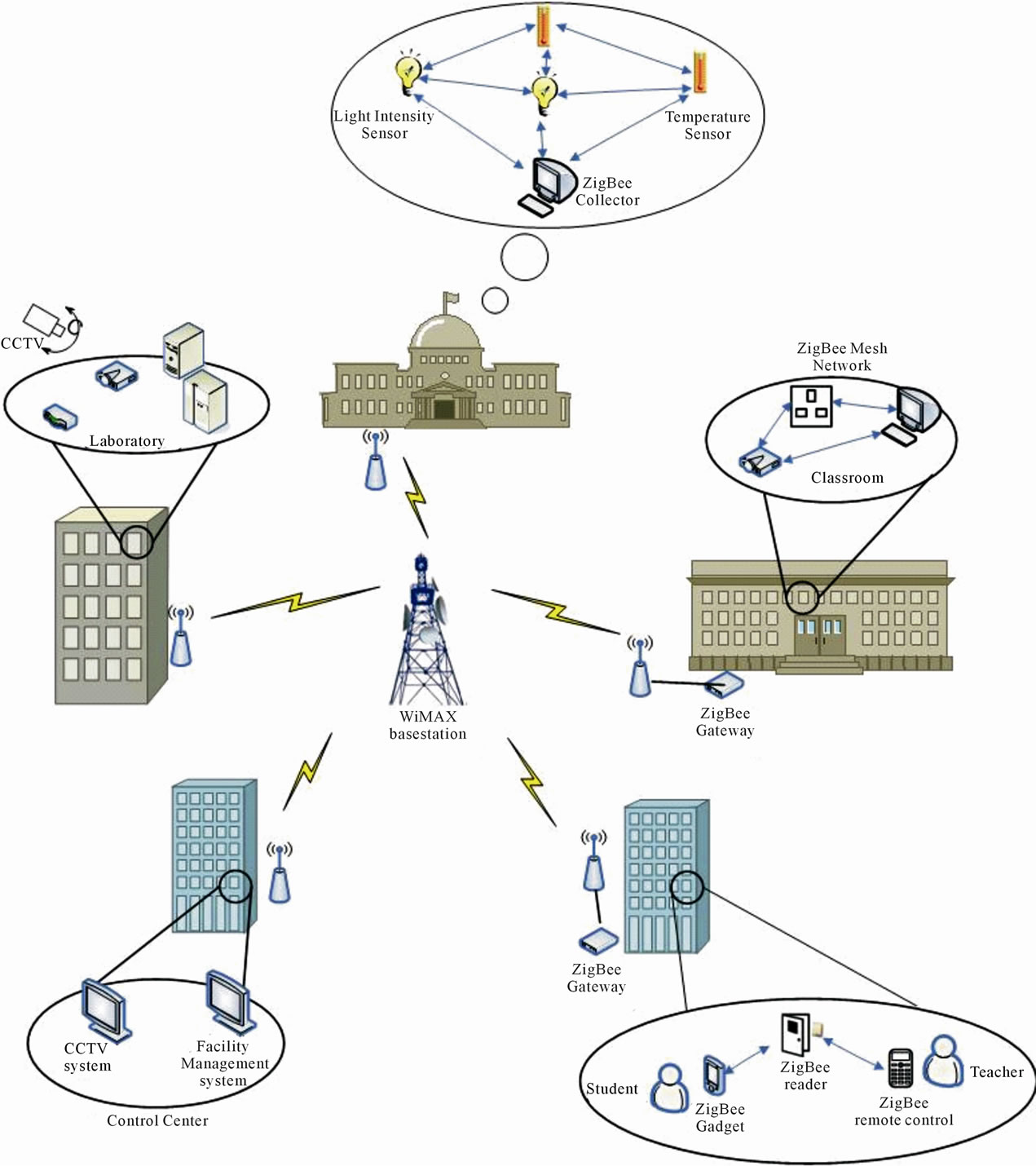
Figure 1. System design in campus.
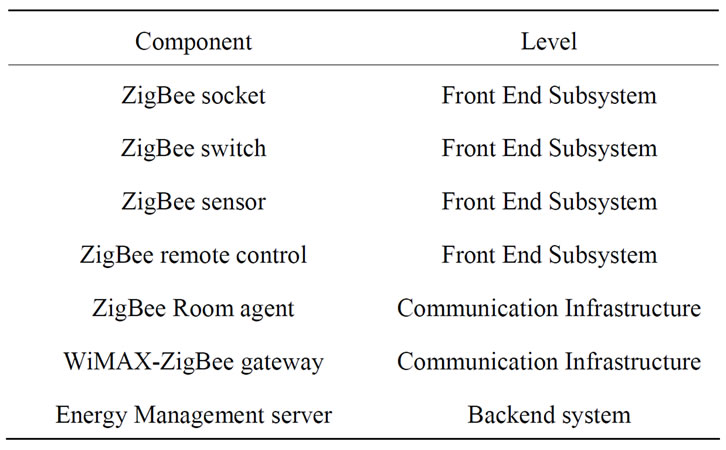
Table 2. System components with tier design.
years. Furthermore, over 65000 ZigBee devices can be registered within a single network. The property of packet relay comprehends all ZigBee devices inside a building or a region for data forwarding. Technical terms for ZigBee devices are ZigBee coordinator (WiMAX - ZigBee gateway), ZigBee router (ZigBee socket, sensor, room agent and switch) and ZigBee end-device (remote control). The data transmission between these devices is considered reliable due to the presence of mesh capability [9]. This handy feature should be heeded since the connection will be guaranteed to reach the destination despite a link fails unexpectedly on the way. Data are generated from ZigBee devices and dynamically find multiple paths for routing if the current path is blocked. The gateway (coordinator) is the heart of the ZigBee network which is responsible for data reception and processing. Successful collection of data should proceed to the backend system via the WiMAX-ZigBee gateway.
2.1.2. Communication Infrastructure
The ZigBee room agent and the WiMAX-ZigBee gateway are two elements of communication infrastructure. The room agent collects the information such as energy consumption, room temperature and humidity for energy management server. On other hand, the energy management server sends the control command to ZigBee switches and sockets in order to optimize energy consumption.
WiMAX-ZigBee gateway is a computer system embedded with a ZigBee coordinator and WiMAX Subscriber Station which is responsible for the collection of data from ZigBee routers. Operating as an intermediary between the control center (Administrative level) and the ZigBee router (User level), the computer system processes and analyzes the ZigBee data. At Departmental Level, the computer system acts as the only coordinator in a single ZigBee network. As for the entire system, each building, department or sports ground requires an individual ZigBee gateway which represents a bridge linking between buildings and the control center. Upon reception of ZigBee data, individual ZigBee gateway computer system converts the data to the format of WiMAX. and the WiMAX data will be transmitted to the control center through WiMAX routing.
WiMAX is a wireless metropolitan area network WMAN standard of IEEE 802.16 [11]. It is contrary to ZigBee attributes and is used for long-range transmission, high data rate for broadband access. Maximum transmission can be covered for 50 km (line of sight LOS), thus WiMAX allows direct data transmission among buildings. For areas without pre-installed physical cable or telephone networks, WiMAX may be a viable alternative for broadband access between ZigBee networks and the campus control center. The WiZEM system is ideal for communication and data exchange between campus buildings.
2.1.3. Backend System
Based on the WiMAX broadband technology, energy consumption and facility management data collected by the ZigBee gateway can be transmitted wirelessly over a long distance to the control center. A user friendly interface monitoring the whole campus is available for the administrator. In the control center, artificial intelligence of fuzzy logic is implemented to assist administrative work by the collected environmental conditions. Fuzzy logic is a popular intelligence on some engineering system and it will be presented in the following section. Statistics on the energy consumption by students are referenced as a performance of energy conservation. Furthermore, the user interface allows the administrator to configure the thermal preference such as temperature and humidity and also preset the operation schedule of ZigBee switches and socketes. Since each building or department has installed an independent ZigBee system, WiMAX facilitates the communication among independent systems so that information exchange can be done easily by wireless means.
2.2. The Role
The proposed system is expected to play significant roles in campus. Firstly, green education can be achieved by the demonstration of the energy management system. After introducing the energy management system, students are involved in the participation of energy saving. Being an integral part of the campus, each student has a mission and responsibility in energy saving. It is believed that the role of education is to cultivate an energy conserving mind at young age. Thus the proposed system presents a hardware solution in accordance with the software concept by education. The fact of energy depletion should be heeded and the consequence of energy wastage should be emphasized to alert users against a hard time in future.
The energy consumption is monitored by the administrator in which approval is set to a specific period or person. This scheduling function prevents the energy consumption from overusing or misusing. Both artificial intelligence and administrator are capable of optimizing the energy consumption by controlling ZigBee sockets and switches. Thus, the proposed energy management system is an indispensable part for campus.
3. System Architecture
The proposed system architecture of WiZEM describes in this section focuses on internetworking between ZigBee and WiMAX. The internetworking architecture (depicted in Figure 2 illustrates the data communication flow between the ZigBee and WiMAX network which serves three purposes: energy management, control and device management.
In Figure 2, the ZigBee Mesh network is established within a building and it comprises of ZigBee controllable appliances (such as switches and sockets), multiple ZigBee room agents and a single WiMAX-ZigBee Gateway. For every classroom, the ZigBee controllable appliance and sensor are configured as the end device which is associated to a room agent. The room agent is a ZigBee router which enables the communication between end device and WiMAX-ZigBee gateway. WiMAX-ZigBee
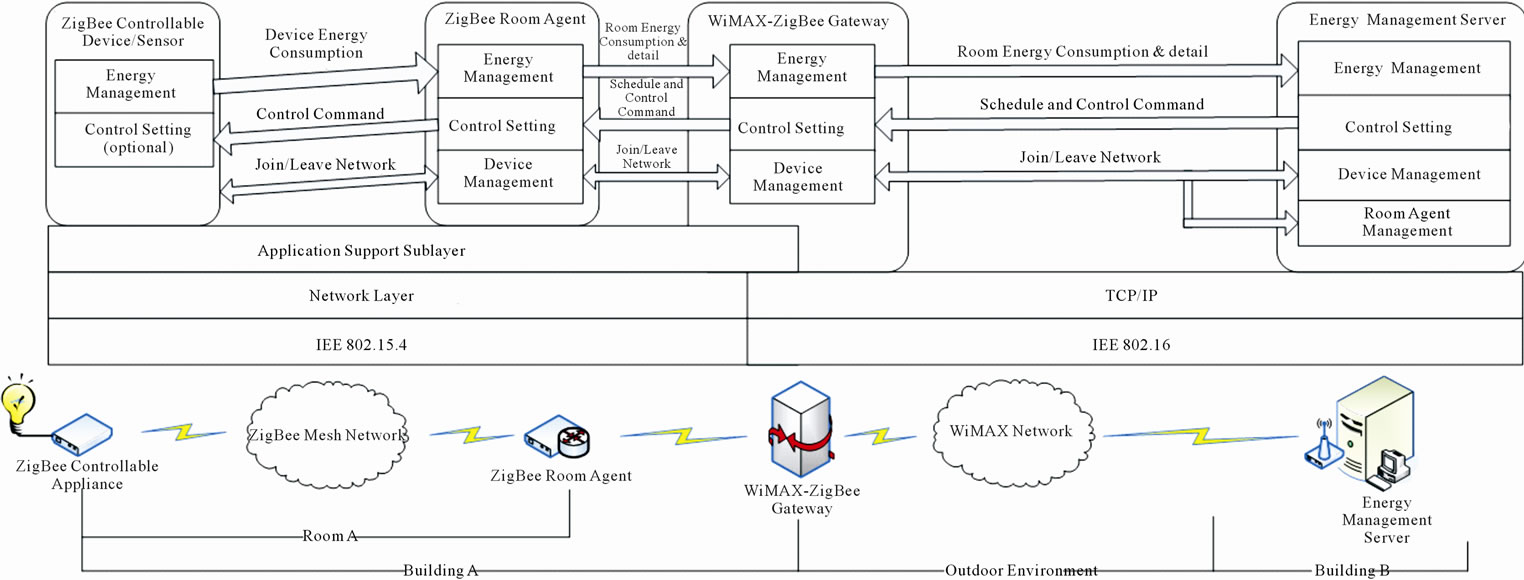
Figure 2. Internetworking Architecture of WiMAX-ZigBee communication.
Gateway is the essence of the entire internetworking architecture which embeds both ZigBee Coordinator and WiMAX Subscriber station modules. With multiple communication interfaces, the WiMAX-ZigBee gateway translates WiMAX signals to ZigBee commands and also converts the ZigBee messages to WiMAX packets. More importantly, the WiMAX-ZigBee gateway provides reliable communication to the energy management server which is also a WiMAX subscriber station. The energy management server optimizes the air conditioner temperature, measured room temperature and humidity. Also, it generates energy consumption report and executes the preset operation schedule. In the following text, the energy management, the control and device management operation of WiMAX are described.
3.1. Device Management
3.1.1. Add Device Process
A new ZigBee device initializes the network joining process (Figure 3) by sending a Device_Join_Request to the room agent and the Device_Join_Request encloses device address and end point which identifies the sender and specifies the responded application. The room agent acknowledges the ZigBee device if the Device_Join_ Request is received. Then, the room agent forwards the request with its address to the WiMAX-ZigBee gateway. The gateway reassembles the ZigBee packet with gateway address (WZG Addr) before sending to WiMAX base station. The WiMAX Base Station routes the Request to the energy management server. The server creates a record in device management database for the new device. The management server then releases the join request results by transmitting Device_Join_Response.
3.1.2. Remove Device Process
A new ZigBee device initializes the remove device process (Figure 4) by sending a Device_Leave_Request to the room agent and the Device_Leave_Request encloses device address and end point which identifies the sender and specified the responded application. The room agent acknowledges the ZigBee device if the Device_Leave_ Request is received. Then, the room agent forwards the request with its address to the WiMAX-ZigBee gateway. The gateway reassembles the ZigBee packet with gateway address (WZG Addr) before sending to WiMAX base station. The WiMAX Base Station routes the Request to the energy management server. The server removes a record in the device management database for the device. Finally, the management server releases the leave request result by transmitting Device_Leave_Response.
3.2. Energy Management
3.2.1. Data Collection Procedure
The energy management server collects the data such as room temperature, humidity and energy consumption from ZigBee controllable devices and sensors using the polling approach (Figure 5). First, the server sends the Energy_Consumption_Request/Energy_info_Request to a specific WiMAX-ZigBee gateway via the WiMAX network. After receiving the request, the gateway identifies polled room agent and translates the packet to ZigBee command. An Energy_Consumption_Request/Energy_info _Request indicating a Room agent address is sent out by the gateway.
The room agent performs room basis data collection which is also a polling process as indicated in Figure 6. After the data is collected, the room agent attaches the collected data to corresponding response (Energy_Consumption_Reponse/Energy_info _Reponse) and sends to the gateway. Then, the gateway issues the Energy_ Con
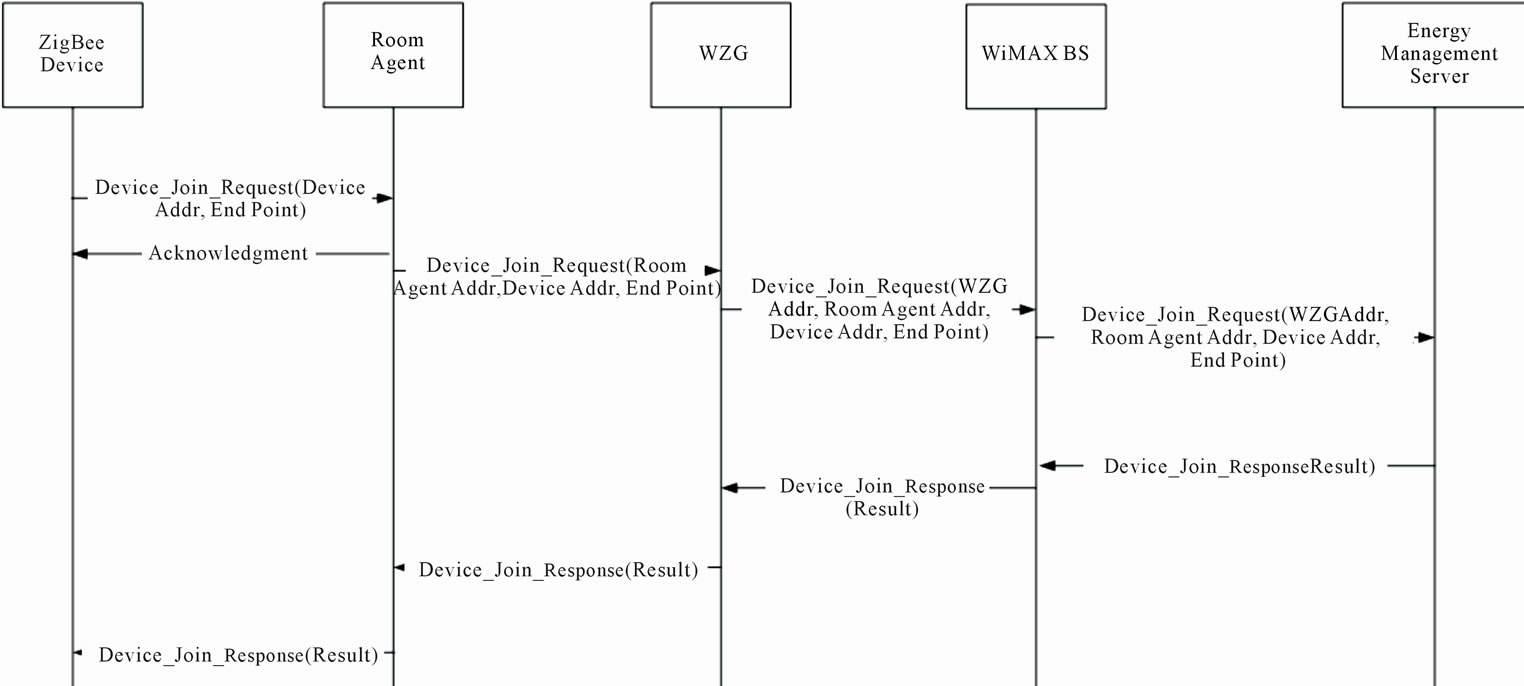
Figure 3. Add device procedure.
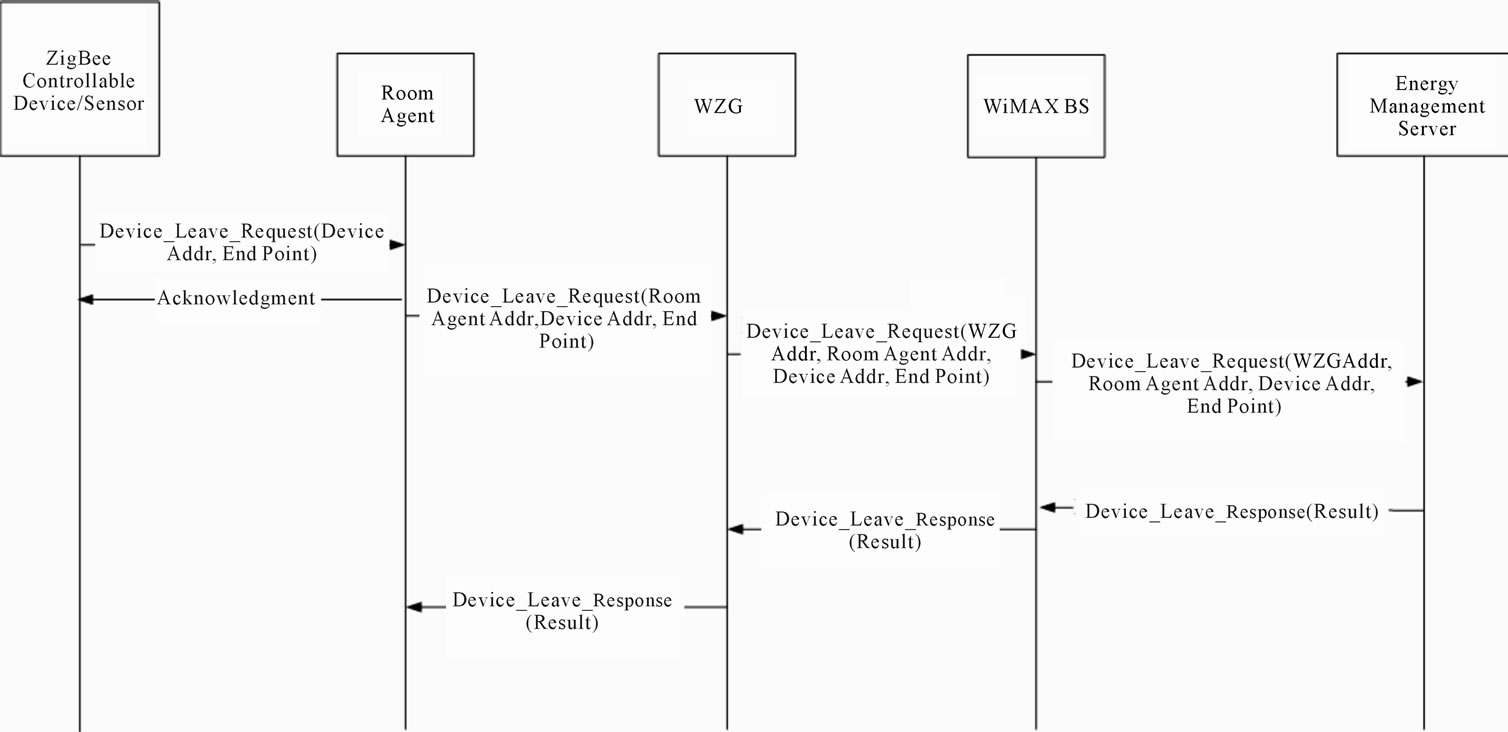
Figure 4. Remove device procedure.
sumption_Request to another room agent. The gate-way repeats the polling process until it collects the datafrom every room. After the polling process is completed, the gateway sends the collected data to energy management server using Energy_Consumption_Reponse/Energy_info _Reponse.
3.2.2. Fuzzy Logic Model in Energy Management
In the proposed WiZEM System, after the ZigBee sensors switch and sockets has collected the environmental and consumption data, a strategy for energy saving is processed by the philosophy of Fuzzy Logic.
The proposed fuzzy logic model contains three steps: fuzzification, fuzzy inference and defuzzification. Fuzzification describes the process that real variables are transformed to linguistic variables with several terms, each having a membership function with a range of [0,1]. Fuzzy inference is the second step. In this step, the linguistic variables are applied to IFTHEN rules for combining conditions and drawing conclusions. At final stage, defuzzification, the concluding rules are transformed back to real variables. The input and output variables are shown below.
The Fuzzy Input Variables (and the Fuzzy Values Options) are:
1) OutDoor-Temperature (Low, Medium, High)
2) OutDoor-Humidity (Low, Medium, High)
The Fuzzy Output Variables (and the Fuzzy Values Options) are:
1) Air-Conditioner-Speed (Slow, Moderate, Fast)
2) Fan-Speed (Slow, Moderate, Fast)
The proposed fuzzy logic model, based on the input and the output variables, makes the decision based on the rules shown in Table 3.
With collected data and user preset device operation schedule, the energy management server issue control commands to devices in order to avoid overuse of energy and the process is illustrated in Figure 7. To control a device, the Energy management server sends a Device_Control_Request to the WiMAX-ZigBee gateway via the WIMAX network. The gateway identifies the room agent which is the destination. Then, it converts the WiMAX signal to the corresponding ZigBee command and sends it to specified room agent. Once the room agent has received the request, it updates the status of corresponding device by Device_Control_Request. After the ZigBee device A made the changes, the ZigBee device A sends the Device_Control_Response to the room agent. The Room agent reports to the gateway by forwarding the request and the gateway will thus inform the

Figure 5. Data collection process.
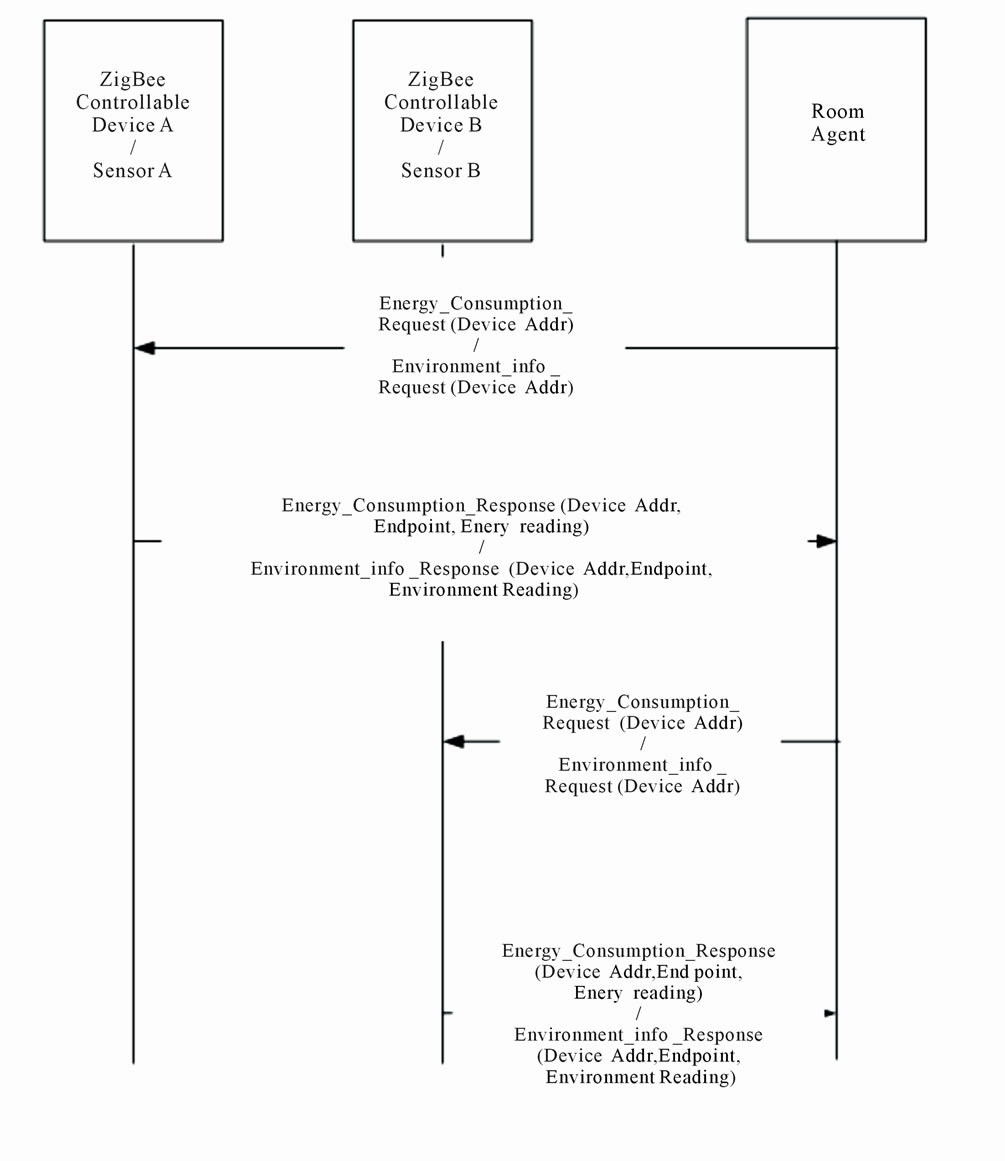
Figure 6. Room data collection process.

Table 3. Basic rules of thermal control.
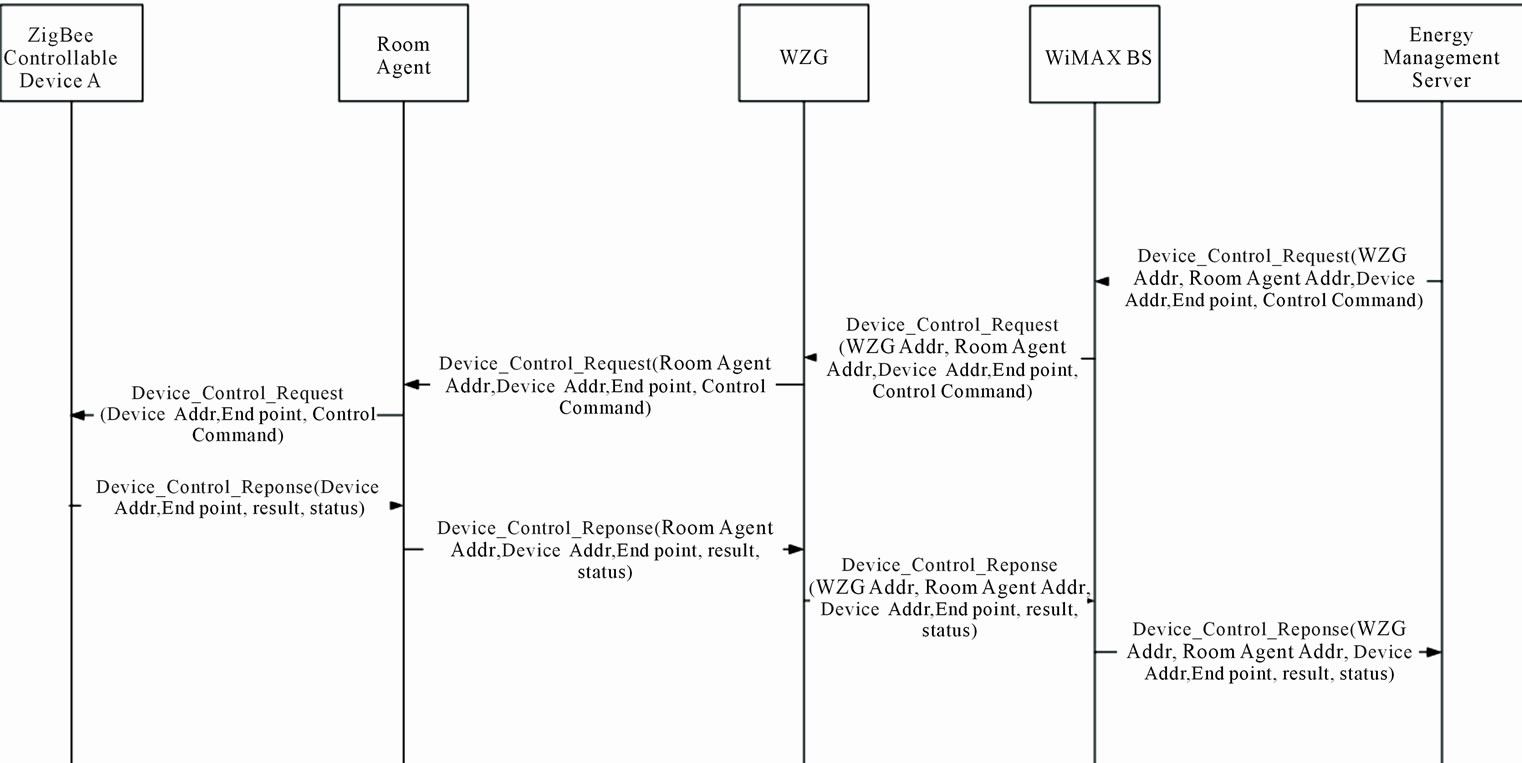
Figure 7. Device control process.
result to the energy management server via a WiMAX communication.
4. Performance Evaluation
To evaluate the performance of WiZEM, a simulation model has been developed with C++ programming. This model simulates the energy consumption in a University Campus. The first scenario has been setup to evaluate the accuracy of the simulation model by comparing the simulation results with 2009 Building Energy Data Book edited by Department of Energy, the US [13]. The comparison and calculated results are shown in Figure 8. In Figure 8, the energy consumption results from simulation model have been organized into five categories: space heating, space cooling, lighting, equipments and other are based on the US Department of Energy’s report. The yearly energy consumption of a public K-12 schools in the United States is shown in Figure 8. The discrepancy of simulation and statistical result for the total energy consumption is about 0.7%. The highest discrepancy of simulation and statistical result is bounded by 2% which is fallen into the category of others which may be attributed to the different classification of appliances. From both statistical and simulation results, space heating is the major source which contributes approximately 40% of total energy consumption. It is then followed by lighting, which contributes about 35% of total energy consumption. Another 11% of energy consumption goes to space cooling. The small discrepancy between simulation and statistical results confirms the reliability of the simu lation model.
Scenario 2 is used to investigate the amount of saved energy after adopting WiZEM. This scenario is based on a campus under the following assumptions:
• Number of floors: 2
• Average area of campus: 7432.243 m2
• Campus Opening hours: 12
The total number of appliances in a campus is shown in Table 4
The room temperature is kept at 22˚C and 25˚C during the heating and cooling space system operation respectively. All other appliances are operated under a preset operation schedule which is configured according to their daily operation. Figure 9 shows the performance of WiZEM by comparing the energy consumption of different appliances before (indicating as normal) and after applying WiZEM (indicating as WiZEM). In both cases, space heating and lighting, equipments are three major consumption sources. Space heating contributes about 1 and 0.5 million kWh before and after applying WiZEM

Figure 8. Comparison of statistics and simulation results.
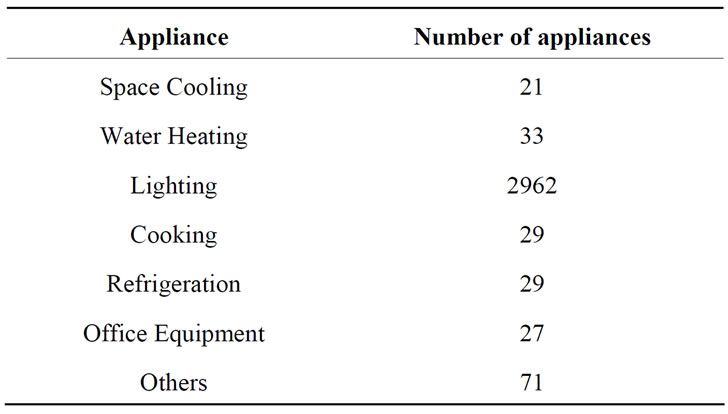
Table 4. The number appliances in scenario 2.
respectively. By switching off, the light from midnight to seven o’clock in morning, 10% of energy is saved and lighting consumes 0.26 and 0.23 million kWh before and after applying WiZEM respectively. Even more importantly, WiZEM decreases the energy usage of equipments from 0.3 to 0.23 million kWh under the preset schedule.
Moreover, space cooling is the fourth major consumption source and is expected to grow continuously. It spends about 0.19 and 0.13 million kWh before and after applying ZiPEM respectively which are about 10% of total energy consumption. From the results shown in Figure 9, WiZEM saved 31% of total energy consumption. Water heating excelled the overall achievement by 7%. The energy saving from space heating and cooling is mainly due to regulating the room temperature at certain level in order to avoid overusing the air conditioning system. To further investigate the performance of WiZEM, the result is compared with the energy benchmark of U.S. government [13] and the average energy benchmark requirement is summarized in Table 5. Originally, the energy consumption of the campus only meets the lighting requirement of the energy benchmark. Fortunately, WiZEM helps the campus to meet all the requirement of the energy benchmark. The result proves that a campus may manage its management consumption effectively with scheduling and indoor temperature regulation feature.
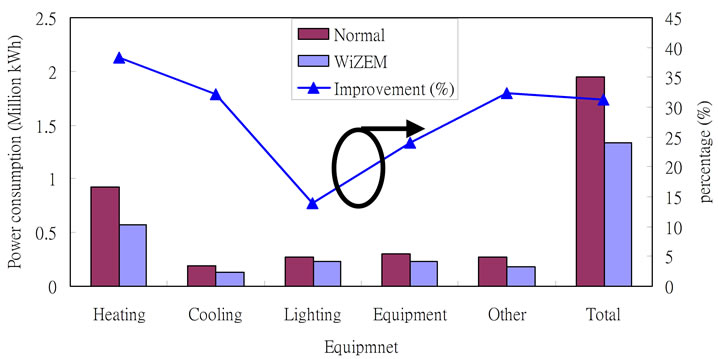
Figure 9. Performance of WiZEM.

Table 5. Energy benchmark overall.
According to [13], the educational facilities consumes 240 million thousand kWh of energy annually. With 30% reduction, WiZEM is estimated to save 72 thousand million kWh every year. In addition, WiZEM relieves the global warming problem by reducing 48 million tons CO2 emission which is estimated by producing 0.67 kg CO2 per kWh. Last but not least, the impact of green education to our next generation will be invaluable.
5. Conclusions
In this paper, an all-round WiMAX-ZigBee Energy Management System is proposed to combat against environmental crisis. The system is a technical breakthrough providing real time monitoring for environmental conditions and energy consumption details as well as facility management. The absence of wiring significantly reduces the cost of deployment and facilitates efficient management in the campus area. Analysis shows that 30% energy can be saved from the total energy consumption which helps the school campus to achieve the US government proposed energy benchmark standard. The projection on the environment reduces 48 million tons CO2 emission. The provision of knowledgeable education on energy conservation should further arouse echoes in the heart of our next generations.
REFERENCES
- Wikipedia, “Renewable Energy,” Retrieved May 20, 2008. http://en.wikipedia.org/wiki/Renewable_energy
- F. W. Gutzwiller, J. E. Francis, E. K. Howell and W. R. Kruesi, “Homenet: A Control Network for Consumer Applications,” IEEE Transactions on Consumer Electronics, Vol. CE-29, No. 3, 1983, pp. 297-304.
- T. C. Matty, “Advanced Energy Management for Home Use,” IEEE Transactions on Consumer Electronics, Vol. 35, No. 3, 1989, pp. 584-588.
- K. P. Wacks, “Utility Load Management Using Home Automation,” IEEE Transactions on Consumer Electronics, Vol. 37, No. 2, 1991, pp. 168-174.
- J. C. Kelly and T. D. Schoechle, “A Residential Energy Management Test Using CEBus,” IEEE Transactions on Consumer Electronics, Vol. 38, No. 4, 1992, pp. 921-926.
- N. Kushiro, S. Suzuki, M. Nakata, H. Takahara and M. Inoue, “Integrated Residential Gateway Controller for Home Energy Management System,” IEEE Transactions on Consumer Electronics, Vol. 49, No. 3, 2003, pp. 629- 636.
- M. Inoue, T. Higuma, Y. Ito, N. Kushiro and H. Kubota, “Network Architecture for Home Energy Management System,” IEEE Transactions on Consumer Electronics, Vol. 49, No. 3, 2003, pp. 606-613.
- C.-H. Lien, Y.-W. Bai and M.-B. Lin “Remote-Controllable Power Outlet System for Home Power Management,” IEEE Transactions on Consumer Electronics, Vol. 53, No. 4, 2007, pp. 1634-1641. doi:10.1109/TCE.2007.4429263
- K. F. Tsang, H. Y. Tung and K. L. Lam, “ZigBee: From Basics to Designs and Applications,” Prentice Hall, New Jersey, January 2009.
- “Air Interface for Fixed Broadband Wireless Access System,” IEEE 802.16-2004 Part 16, 2004
- “Air Interface for Fixed Broadband Wireless Access Systems—Amendment for Physical and Medium Access Control Layers for Combined Fixed and Mobile Operation in Licensed Bands,” IEEE Standard 802.16e, December 2005.
- G. J. Klir and B. Yuan, “Fuzzy Sets and Fuzzy Logic: Theory and Applications,” Prentice-Hall, New Jersey, 1994.
- “2009 Building Energy Data Book, U.S. Department of Energy,” D & R International, Ltd., 12 December 2009. http://buildingsdatabook.eren.doe.gov/docs/DataBooks/2009_BEDB_Updated.pdf
NOTES
*The support from CC Technology Ltd. is gratefully acknowledged.

